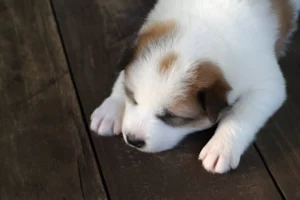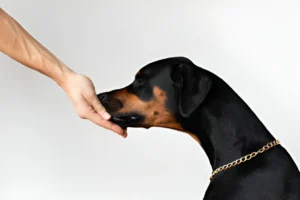The Complete Guide to Dog Tail Biting: Causes, Treatments, and Prevention
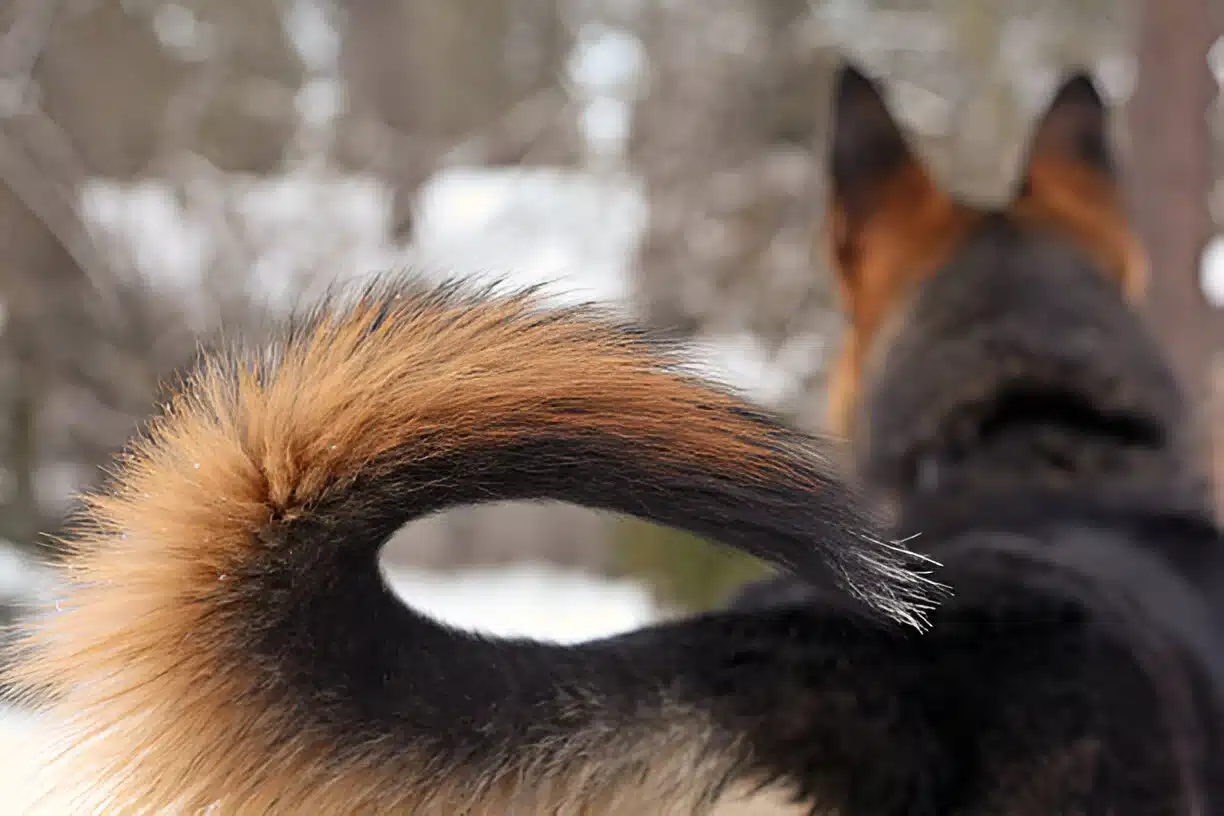
Dogs biting their tails is a common behavior. It can signal health or behavioral problems. Occasional tail biting might seem okay. However, constant chewing can cause infections and wounds. It can even lead to long-term medical issues. Understanding the reasons for this behavior is important. It helps pet owners keep their dogs healthy.
Medical Causes
Why do dogs bite their tails? Several factors contribute to this. These include minor irritations like flea bites. More serious problems include anxiety or neurological issues. Dogs may bite their tails because of skin allergies. Parasites and infections are other causes. Stress can also lead to compulsive tail biting. Without treatment, this can become a habit. It will negatively impact a dog’s well-being.
Parasites: Fleas, Ticks, and Mites
External parasites often cause tail biting. Fleas, ticks, and mites irritate a dog’s skin. The tail is hard for dogs to reach with their paws. So, they bite and chew to find relief.
- Fleas: These tiny parasites cause allergic reactions. A single flea bite can cause flea allergy dermatitis. This makes dogs itch a lot. It also leads to hair loss and skin inflammation. This is especially true around the tail base.
- Ticks: These parasites attach to a dog’s skin. They are often found around the tail and hindquarters. They cause constant scratching and biting.
- Mites (Mange): Sarcoptic and demodectic mange cause severe itching. They also lead to scabbing and skin infections. This makes dogs bite their tails a lot.
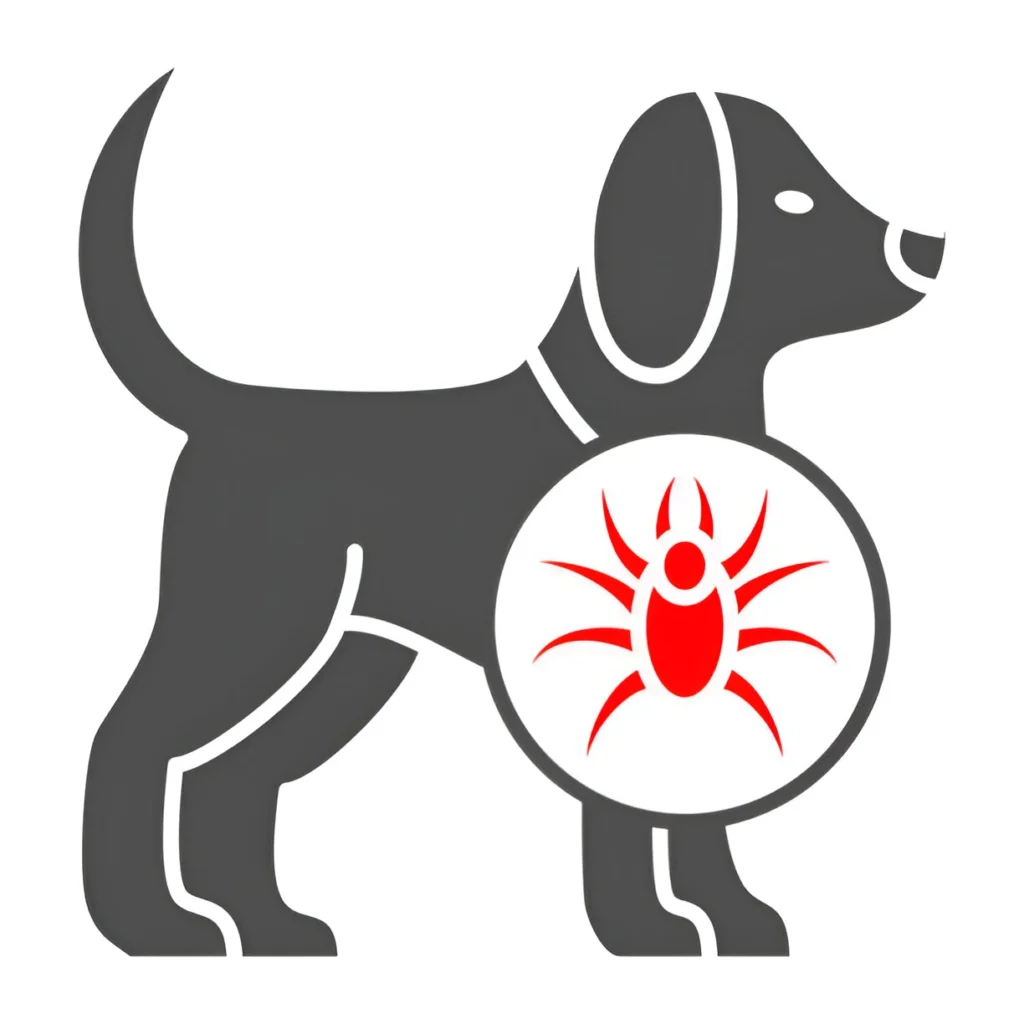
Allergies: Food, Environmental, and Contact Irritants
Dogs can have allergies like people. These allergies make their skin itchy. Tail biting is often a sign of an allergic reaction. This can be due to:
- Food Allergies: Ingredients like chicken, beef, dairy, or grains can cause skin problems. This leads to itching around the tail and hind legs.
- Environmental Allergies: Pollen, dust mites, mold, and grass can cause itching. This may be seasonal or year-round. Dogs may chew on their tails for relief.
- Contact Allergies: Some dogs react to fabrics, shampoos, or cleaning products. This leads to skin irritation. The tail and belly are sensitive areas.
Infections: Bacterial and Fungal Issues
Constant licking and biting opens the skin. This makes it easy for bacterial and fungal infections to start. Open wounds can become inflamed. This can lead to hot spots. These are painful, red, and oozing skin lesions. Fungal infections like ringworm can also cause itching and hair loss. This can occur in the tail area.
Injuries and Pain: Fractures, Nerve Damage, and Arthritis
Tail biting isn’t always about itching. It can be due to pain. This can be from an injury or medical condition.
- Tail Fractures: A broken or sprained tail hurts. This makes dogs bite the area.
- Nerve Damage: Cauda equina syndrome is a spinal nerve disorder. It can cause shooting pain. This can make dogs bite their tails a lot.
- Arthritis: Older dogs with arthritis may have pain in their hindquarters. They may focus on their tails because of this.
Behavioral and Psychological Causes
What if your dog doesn’t have a medical problem? Then the issue might be behavioral. It could also be psychological. Dogs can develop compulsive behaviors. This can be due to boredom, anxiety, or learned habits. Understanding these triggers is important. It helps pet owners deal with the cause. It also helps prevent the behavior from getting worse.
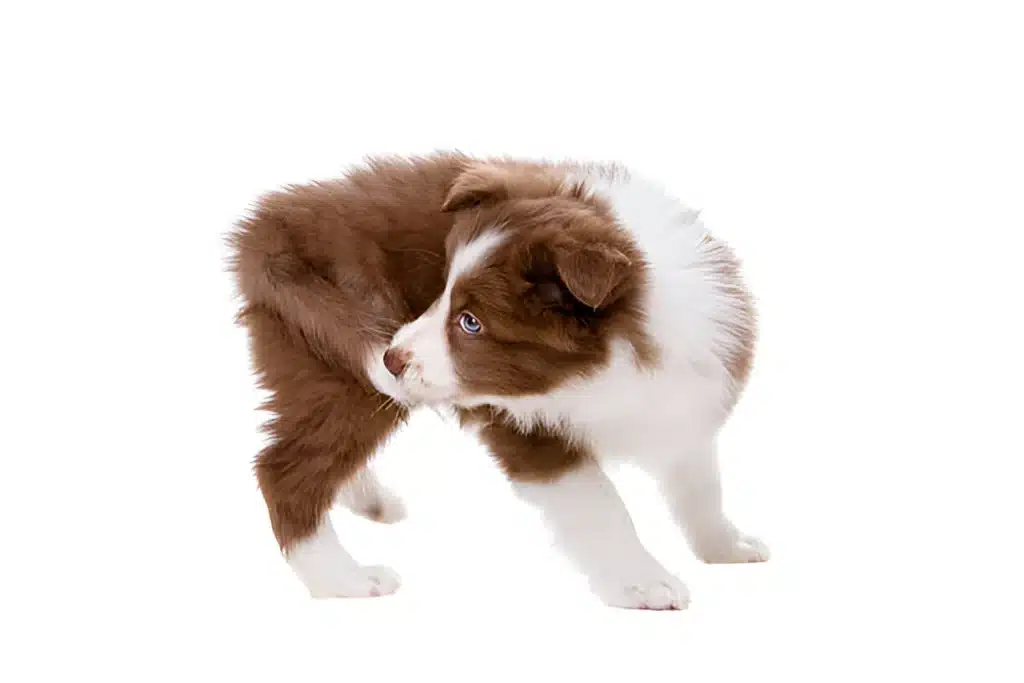
Boredom and Lack of Mental Stimulation
Boredom is a common reason for tail biting. Dogs are smart. They need exercise and mental activity. When left alone for hours without stimulation, they get bored. They may develop habits like tail chasing. Licking or biting are other possibilities. These behaviors help them entertain themselves.
- Increase daily exercise. Longer walks and play sessions are good. Agility training can also help.
- Provide puzzle toys and interactive feeders. These stimulate a dog’s mind.
- Do training exercises. These encourage focus and learning.
Anxiety and Stress-Related Behaviors
Dogs can develop anxiety. This often leads to compulsive behaviors like tail biting. Common stressors include:
- Separation Anxiety: Dogs left alone for long periods may resort to self-destructive behaviors like tail chewing.
- Environmental Changes: Moving, new pets, or loud noises can cause anxiety. This can lead to tail biting.
- Lack of Socialization: Poor early socialization can cause nervous behaviors. This makes a dog more likely to engage in tail chewing.
- Use calming aids. Pheromone diffusers and anxiety wraps can help. Natural supplements are another option.
- Establish a consistent routine. This can reduce anxiety.
- Gradually expose your dog to stressful triggers. Do this in a controlled and positive way.
Canine Compulsive Disorder (CCD)
Some dogs bite their tails a lot. They do this without a medical or environmental cause. They might have Canine Compulsive Disorder (CCD). This is like OCD in humans. It causes obsessive behaviors. These include tail biting, spinning, or excessive licking. Some breeds are more prone to CCD. Bull Terriers and German Shepherds are examples.
- Behavioral training with positive reinforcement can help. It can redirect the dog’s attention.
- Medication may be needed for severe cases. A vet can prescribe antidepressants.
- Reduce stressors in the environment. This can prevent compulsive behaviors from getting worse.
Attention-Seeking Behavior
Dogs are clever. They learn what gets them attention. If a dog gets attention for tail biting, they may keep doing it. This can happen even if it started as a harmless action.
- Ignore unwanted behavior. Reinforce positive behaviors instead.
- Redirect their focus to toys or training. Do this when they try to bite their tail.
- Avoid scolding or overreacting. This can encourage the behavior.
Other Possible Causes
Other factors can explain tail biting. Poor grooming and hormonal imbalances are examples. Nutritional deficiencies can also play a role. Identifying these less common causes is important. It helps pet owners take steps to prevent tail biting.
Poor Grooming and Hygiene Issues
Dogs with long fur are prone to matting. This is especially true around the tail. Matted fur traps dirt and pests. This causes discomfort and itching. If a dog isn’t groomed, they may bite and chew. This is their way of relieving the irritation.
- Brush your dog’s coat often. This prevents matting.
- Bathe your dog with hypoallergenic shampoo. This keeps their skin healthy.
- Check the tail area often. Look for signs of irritation or trapped debris.
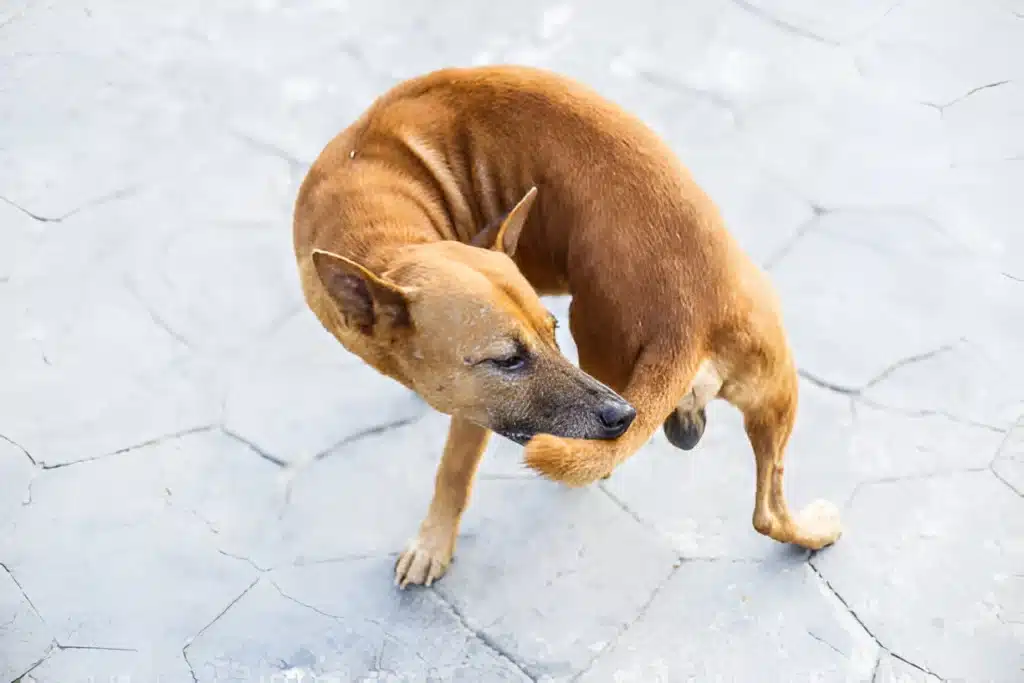
Hormonal Imbalances (Cushing’s Disease and Hypothyroidism)
Hormonal imbalances affect a dog’s skin and coat. This can cause itchiness and hair loss. It can also lead to excessive licking or tail biting. Two common conditions are:
- Cushing’s Disease: The dog’s body makes too much cortisol. This causes thinning skin and hair loss. It also increases the risk of skin infections.
- Hypothyroidism: A lack of thyroid hormones causes dry skin. It can also lead to constant itching. This makes dogs more likely to bite their tails.
- A vet needs to diagnose these issues. Blood tests are necessary.
- Medication can help manage these conditions. Dietary adjustments may also be needed. These steps can reduce tail biting.
Nutritional Deficiencies and Poor Diet
A dog’s diet is important for healthy skin and fur. A lack of nutrients can cause dry, itchy skin. This makes dogs more likely to bite their tails.
- Omega-3 & Omega-6 Fatty Acids: These help skin hydration. They also reduce inflammation.
- Protein Deficiency: Low-quality diets lack protein. This can lead to skin problems. It can also cause excessive scratching.
- Vitamin Deficiencies: A lack of vitamin E, biotin, or zinc can cause brittle fur. It can also irritate the skin.
- Feed your dog a balanced, high-quality diet. It should have essential fatty acids, vitamins, and minerals.
- Consider adding fish oil supplements. These promote healthy skin.
- Make sure your dog is hydrated. Dehydration can also cause dry, itchy skin.
How to Stop Your Dog from Biting Its Tail
Understanding the causes of tail biting is the first step. The next is taking action to stop it. Treatment depends on the cause. It’s important to address medical, behavioral, and environmental factors. This ensures long-term relief.
Veterinary Treatment for Medical Issues
If your dog’s tail biting is due to a medical issue, a vet visit is important. The vet can diagnose the problem. They can also prescribe the right treatment.
- For Parasites: Use vet-approved flea and tick prevention. This includes medications and topical treatments. Flea collars are another option.
- For Allergies: A hypoallergenic diet may be needed. Antihistamines and medicated shampoos can help with environmental allergies.
- For Infections: The vet may recommend antibiotics or antifungal medications. Antiseptic sprays are another possibility. This is for bacterial or fungal infections.
- For Injuries and Pain: Treatment may involve pain management. Physical therapy or surgery might be needed. This depends on the severity.
Regular vet checkups are a good idea. They can help catch health issues early. This can prevent chronic tail-biting habits.
Behavioral Training and Mental Stimulation
Tail biting can be caused by boredom or anxiety. It can also be a compulsive behavior. Changing your dog’s routine can help. Modifying their environment is also beneficial.
- Increase Exercise: Daily walks and playtime are important. Agility training can also help. A tired dog is less likely to be bored.
- Provide Mental Stimulation: Puzzle toys and chew toys keep dogs busy. Treat-dispensing games are another option. These help engage their minds.
- Reduce Anxiety: A consistent routine can help. Soothing music can also be calming. Anxiety wraps are another possibility.
- Positive Reinforcement Training: Reward your dog when they stop biting their tail. Use treats and praise. Avoid punishment. It can increase anxiety. It can also make the behavior worse.
If compulsive tail biting continues, seek professional help. A dog trainer or behaviorist can offer specialized techniques.
Environmental Changes for Better Comfort
Some things in the environment can trigger tail biting. Making changes can help. It can remove these irritants.
- Improve Grooming: Brush your dog’s coat often. Trim fur around the tail. Use hypoallergenic shampoo. This prevents matting and irritation.
- Use an Elizabethan Collar (E-Collar): An E-collar can prevent further biting. This is helpful while the area heals.
- Check for Household Irritants: Avoid harsh cleaning products. Air fresheners and fabric softeners can also irritate.
- Provide a Comfortable Living Space: A clean, soft bed is important. A stress-free environment can minimize anxiety.
If seasonal allergies are the cause, wipe your dog’s paws and tail. Do this after outdoor walks. A damp cloth can remove pollen and allergens.
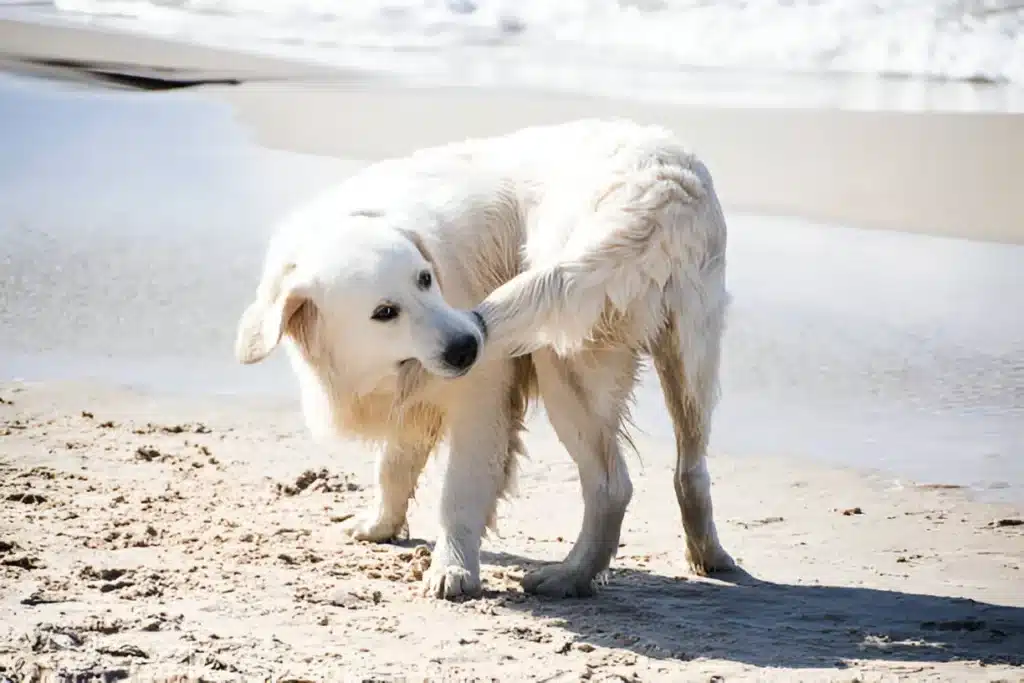
When to See a Vet About Tail Biting
Occasional tail biting may not be a problem. However, constant biting can mean something serious. Knowing when to see a vet is important. It can prevent complications. These include infections, chronic pain, or behavioral disorders.
Signs That Require Immediate Veterinary Attention
If you see any of these signs, see a vet right away:
- Bleeding or Open Wounds: Repeated biting can break the skin. This can lead to sores and infections.
- Hair Loss Around the Tail: Excessive chewing can cause bald patches. This could mean allergies or parasites. Fungal infections are another possibility.
- Foul Odor or Discharge: A bad smell can mean infection. Pus or crusty buildup is another sign.
- Swelling or Redness: If the tail is inflamed, there may be an injury. A skin infection is another possibility.
- Constant Whining or Discomfort: If your dog seems restless, they may be in pain. Difficulty sitting can also indicate a problem.
- Repeated Tail Chasing and Obsessive Licking: This could be a sign of CCD. It can also mean extreme anxiety.
Don’t wait until the condition gets worse. Early intervention is important. It can prevent further damage. It also ensures your dog gets the right treatment.
What to Expect During a Vet Visit
The vet will examine your dog. They will try to find the cause of the tail biting. The process may include:
- Physical Examination: The vet will check the tail and skin. They will also look for signs of infection.
- Allergy Testing: If allergies are suspected, the vet may suggest an elimination diet. Allergy testing is another option.
- Skin Scrapings or Cultures: These tests can diagnose infections. They can also identify parasites.
- X-rays or Imaging Tests: These tests can check for injuries or nerve damage. Spinal issues can also be detected.
- Behavioral Assessment: If the issue seems compulsive, a behaviorist may be consulted.
Keep track of your dog’s symptoms. Note when the tail biting started. Mention any changes in diet or environment. Tell the vet if the behavior changes at certain times. This information can help the vet make a diagnosis.
Final Thoughts on Tail Biting in Dogs
Understanding why dogs bite their tails is important. It helps you take care of your pet. Occasional tail biting may be okay. However, constant chewing can mean a problem. Finding the cause early can prevent complications. It can also improve your dog’s quality of life.


